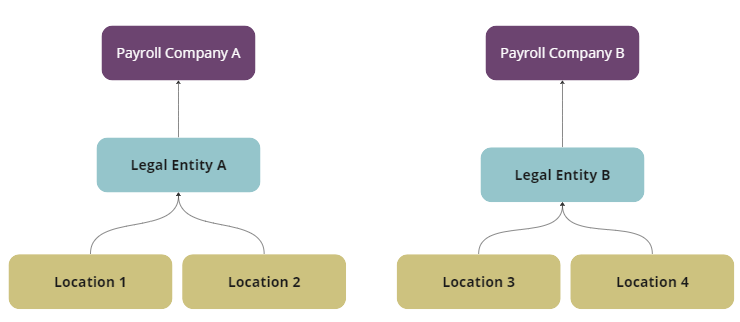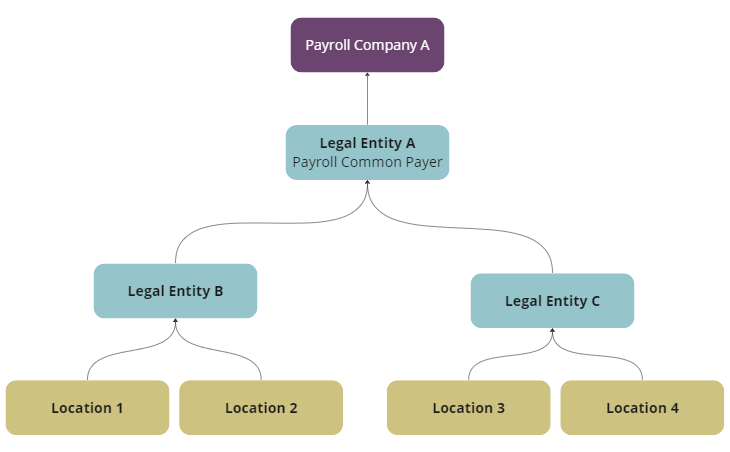This article is an overview of how Payroll Companies and Payroll Journal Entry Clearing Settings are configured for Workforce.
Payroll Company Setup
Payroll Companies are used only within Workforce and represent the company associated with a single EIN for the purpose of Payroll processing. Within Workforce, Payroll Companies are associated with Payroll Batches, Employee distributions (direct deposit, check, pay card), and tax reporting.
Payroll Company details are managed by R365. For assistance with adjusting the details for a Payroll Company, please contact R365 Support.
Many of the pages within Workforce display only a single Payroll Company at a time. The displayed Payroll Company can be changed using the Payroll Company drop-down.
Legal Entities
Typically, each Payroll Company is paired with a single legal entity in Accounting. This results in Payroll Batches, Employee distributions, and tax filings that are grouped at the Legal Entity level. Employees who work at multiple Locations will receive one Paycheck per Legal Entity associated with their work Locations.
Payroll Common Payer
When multiple Legal Entities within Accounting process Payroll under one EIN, a single Legal Entity is configured as a Payroll Common Payer in Accounting, then paired with a single Payroll Company. This results in Payroll Batches, Employee distributions, and tax filings that are grouped at the Payroll Common Payer Level. When an Employee works at multiple Locations, they will receive one Paycheck for each Payroll Common Payer associated with the Legal Entities associated with their Work Locations.
Changes to common payer settings after employees are onboarded can cause payroll and accounting disruptions. Only make changes when absolutely necessary.
Learn more about Payroll Common Payers.

Paycheck Runs and Payroll Journal Entries
The Payroll Clearing setting in System Preferences determines how Paycheck Runs and Payroll Journal Entries are grouped on creation when a Payroll Batch is approved.

The Payroll Clearing setting also determines if Estimated Payroll Journal Entries are cleared individually or as a group. Estimated Payroll Journal Entries are created per Location when the DSS for a Location is polled. When an actual Payroll Journal Entry is created, the estimate is cleared. Learn more about Estimated and Actual Payroll Journal Entries here.
Setting | Paycheck Runs Created | Payroll Journal Entries Created | Payroll Journal Entry Clearing |
|---|---|---|---|
Per Location |
| 1 batch per location | Includes multiple employees with multiple locations in the batch. The journal entry will have one header location which matches the location of the paycheck run. |
Per Legal Entity |
| 1 batch per Legal Entity | Each Journal Entry includes earnings from all locations within the Legal Entity |
Per Payroll Common Payer | Paycheck run grouping is per Common Payer. | 1 batch per Common Payer group | Each Journal Entry includes earnings from all locations across all Legal Entities in the Common Payer group |
For organizations using per location payroll clearing, the header location of the payroll journal entry will match the location of the paycheck run.
The Per Location and Per Legal Entity options cannot be used with a Payroll Common Payer setup. The per Payroll Common Payer option must be used when a Payroll Common Payer setup is in place.
Paycheck Run and Payroll Journal Entry Clearing Examples: |
|---|
|
Employee Earnings at Multiple Locations
In Beta
This feature is in beta. Contact your CSM to learn more.
Depending on the selected setting—Per Location, Per Legal Entity, or Per Common Payer—paychecks and journal entries are generated differently to ensure accurate payroll and financial reporting.
Per Location
Under the Per Location payroll clearing option, the paycheck run and journal entry are created based on the following prioritization logic:
Primary Location Prioritization:
If all worked locations are within the same legal entity as the employee's primary location, the paycheck run and journal entry are created for the primary location.
All earnings across locations within that legal entity are included in this single paycheck run and journal entry.
Multiple Legal Entities:
If the location belongs to the same Legal Entity as the employee’s primary location, the paycheck run uses the primary location. The journal entry will also reflect this location in the header.
If the location belongs to a different Legal Entity than the employee’s primary location, the paycheck run uses the Legal Entity’s default payroll location. The journal entry header reflects the same location.
In this case, the employee will have a separate paycheck run and journal entry for each legal entity worked. This will result in multiple payments, paystubs, and W-2 forms for the employee.
Example Scenario 1: Multiple locations including primary location.
The employee works 40 hours:
10 hours at the primary location.
30 hours at other locations within the same legal entity.
Result:
The paycheck run and journal entry are created for the primary location.
The journal entry includes all hours worked across locations in the same legal entity.
Earnings lines in the journal entry are assigned to each work location.
Example Scenario 2: Multiple locations in the same legal entity excluding primary location.
The employee works 40 hours:
No hours at the primary location.
10 hours in one location and 30 hours in another location (all within the same legal entity).
Result:
The system creates a single paycheck run using Default Payroll Location of the legal entity worked.
The journal entry includes all hours worked across both locations.
Earnings lines in the journal entry are assigned to each work location.
Example Scenario 3: Multiple locations in multiple legal entities excluding the primary location.
The employee works 40 hours across multiple legal entities:
Earnings are in locations within two different legal entities.
Result:
Paycheck runs and journal entries use the Default Payroll Location for each legal entity.
Per Legal Entity
Under the Per Legal Entity setting, paycheck runs and journal entries are created for each legal entity where the employee worked.
Primary Legal Entity Prioritization:
If all earnings are within the employee’s primary legal entity, the paycheck run and journal entry are created for the primary legal entity.
All earnings across locations within that legal entity are included in a single paycheck run and journal entry.
Multiple Legal Entities
A separate paycheck run and journal entry is created for each legal entity worked.
Each journal entry uses the Default Payroll Location for that legal entity as the header location.
Job or primary location assignments do not impact which location is used on the journal entry.
The employee receives separate payments, pay stubs, and W-2 forms for each legal entity.
Example Scenario 1: Multiple locations including primary legal entity.
The employee works 40 hours:
10 hours in their primary legal entity.
30 hours at other locations within the same legal entity.
Result:
The paycheck run and journal entry are created for the primary legal entity.
The journal entry includes all hours worked across locations in the same legal entity.
Earnings lines in the journal entry are assigned to each work location.
Example Scenario 2: Multiple locations in multiple legal entities.
The employee works 40 hours across multiple legal entities:
10 hours in one legal entity and 30 hours in another.
Result: The system creates two separate paycheck runs and journal entries:
One for the first legal entity (10 hours).
The journal entry includes all hours worked across locations in the same legal entity.
Earnings lines in the journal entry are assigned to each work location.
One for the second legal entity (30 hours).
The journal entry includes all hours worked across locations in the same legal entity.
Earnings lines in the journal entry are assigned to each work location.
Example Scenario 3: The employee works in locations where no job is assigned.
Result: The journal entry header is set to the legal entity’s Default Payroll Location, while earnings lines are assigned to the work locations.
Per Payroll Common Payer
Under the Per Common Payer setting, paycheck runs and journal entries are consolidated for legal entities within the common payer relationship.
Within the Common Payer Relationship:
All earnings within legal entities associated with the common payer are combined into a single paycheck run and journal entry.
The employee’s primary legal entity is prioritized if they work there.
Outside the Common Payer Relationship:
If the employee works in a legal entity that is not part of the common payer hierarchy, a separate paycheck run and journal entry are created for that legal entity.
In this case, the employee will have a separate paycheck run and journal entry for each legal entity worked outside of the common payer relationship. This will result in multiple payments, paystubs, and W-2 forms for the employee.
Example Scenario 1: Multiple locations including a legal entity within common payer relationship.
The employee works across two locations in two separate legal entities (Legal Entity 1 and Legal Entity) within the same common payer relationship.
Result:
A single paycheck run and journal entry are created under the Common Payer’s Legal Entity
The journal entry header location is the Default Payroll Location of the Common Payer’s Legal Entity.
Earning lines in the journal entry are assigned to the work locations.
Example Scenario 2: Multiple locations, one in the common payer relationship, and one out.
The employee works some hours in Legal Entity 2, which is in the payroll common payer relationship, and some hours in Legal Entity 3, which is outside the common payer relationship.
Result: Two separate paycheck runs and JEs are created:
One for the legal entities within the common payer relationship, consolidated under the common payer parent Legal
Entity.
The journal entry header location is the Default Payroll Location for the common payer parent.
All earnings within the common payer group are included, with line items assigned to the worked
locations.
One for the legal entity outside the hierarchy, using the location rules on the Per Location or Per Legal Entity.
